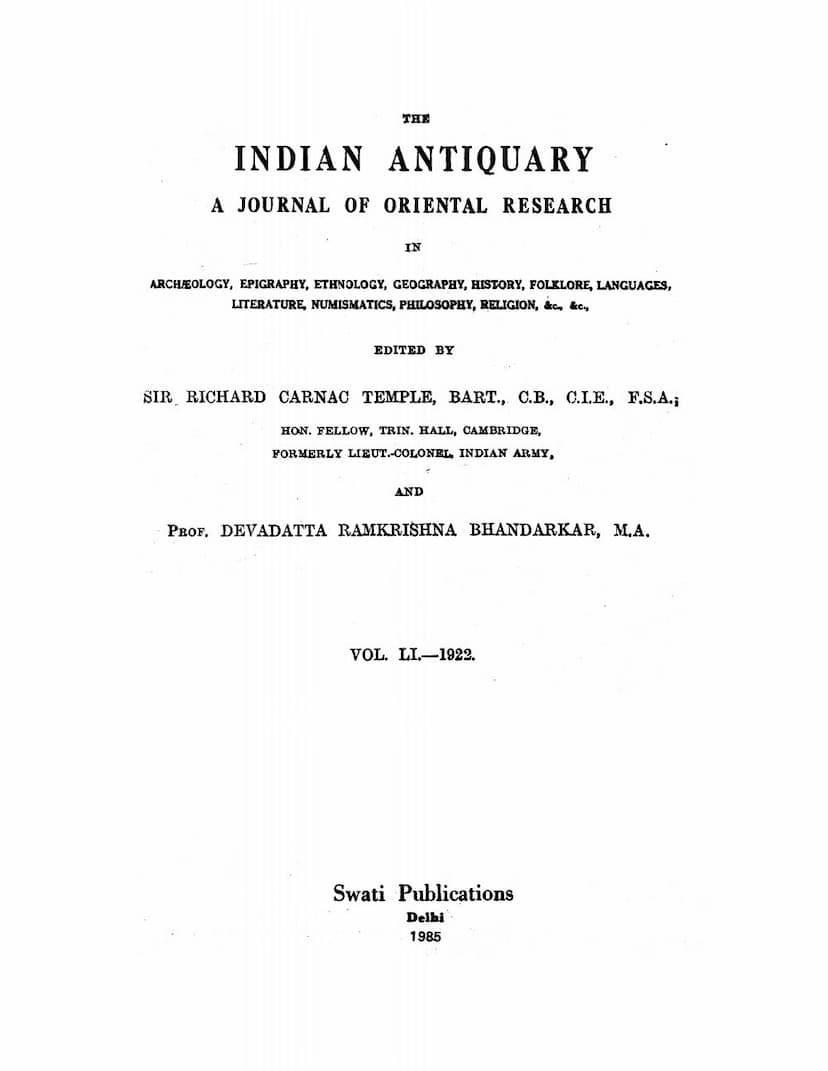Indian Antiquary Vol 51
Added to library: September 1, 2025

Summary
The provided text from the Indian Antiquary, Vol. LI (1922), is a compilation of various articles, book reviews, and miscellanea related to Oriental research. While not exclusively a Jain text, it contains several articles and mentions relevant to Jainism or Jain scholars. The primary focus of the volume appears to be on Indian history, archaeology, languages, and religion, covering a broad range of topics.
Here's a breakdown of the relevant content related to Jainism or Jain scholars within the provided text:
-
Mentions of Jain Scholars and Works:
- Professor Jacobi: His edition of the Bhavisatta Kaha is mentioned in the context of the importance of Apabhramsa in linguistic history, highlighting the contribution of Jain scholars to linguistic research (Page 17).
- Hemachandra: His grammar on Prakrit and specifically his treatment of Paisāciprakṛta are discussed in an article by P. V. Ramanujaswami. The article analyzes Hemachandra's categorization of Paisācika dialects and compares it with other grammarians, suggesting that Hemachandra recognized only two varieties (Page 51, 52, 53, 60, 61, 62). The text notes that Hemachandra's grammar is a key resource for the study of Prakrit dialects.
- Trivikrama and Crutasagara: These Jain Prakrit grammarians are mentioned for their close following of Hemachandra and their clarification of Câlik&-paiçáci, indicating their contribution to linguistic studies (Page 61, 62).
- Hemachandra's Grammar: The article specifically discusses the section on Paisāciprakṛta in Hemachandra's grammar, analyzing his sutras and glosses (Page 61).
-
General Relevance to Indian Culture and Religion:
- Vachanas Attributed to Basava: This extensive section (Pages 7-17, 36-40, 54-60, 63-66, 225-228) discusses the Vira Saiva (Lingayat) sect, its founder Basava, and their philosophical and ethical teachings expressed in Vachanas. While the Vira Saiva tradition is distinct from Jainism, the detailed exploration of religious and ethical practices, stages of spiritual progress (Bhakti, Mahesa, Prasada, etc.), and the emphasis on morality, devotion, and oneness with Siva provide a broad context of Indian religious thought that can be compared with Jain principles.
- Apabhramsa Language: The article by Sir George Grierson on the Apabhramsa Stabakas of Rama-Sarman (Tarkavagisa) (Pages 13-28, 35-36, 166, 175-178, 184-185, 191-198) highlights the importance of Apabhramsa in the linguistic history of India. Apabhramsa literature, often patronized by Jain scholars and kings, is crucial for understanding the development of Indo-Aryan languages, and its study is relevant to Jain linguistic heritage.
- "Sûdra": An article by Pandit Vidhuśekhara Bhattacharya discusses the derivation and meaning of the word "Sûdra," exploring its potential origins and linguistic connections, including references to Buddhist texts and Prakrit influences (Pages 138-141). The analysis of word origins and linguistic shifts is a field of study relevant to understanding the evolution of languages, including those associated with Jain literature.
- Land System in Accordance with Epigraphic Evidence: This article by Kishori Mohan Gupta (Pages 73-79, 81-88) delves into various types of land classifications (village, low lands, high lands, pasture land, sterile land, forest land, cultivable land) and legal terms found in ancient Indian inscriptions. While not exclusively Jain, the study of inscriptions is fundamental to understanding ancient Indian society, administration, and religious practices, which would include the patronage of Jainism by various rulers and the land grants made to Jain institutions.
- The Great Indian Antiquities: The entire volume is a testament to the rich history and diverse cultural landscape of India, which includes the significant contributions of Jainism to its art, architecture, literature, and philosophy. Many articles, even those not directly mentioning Jainism, contribute to the broader understanding of the historical periods and cultural contexts in which Jainism flourished.
In summary, while the Indian Antiquary, Vol. LI, is a general journal of Oriental research, the provided pages contain valuable discussions on linguistic studies, particularly concerning Prakrit and Apabhramsa, where Jain scholars and their works are referenced. Furthermore, the exploration of broader Indian religious and social history, such as the Vachanas attributed to Basava, indirectly touches upon themes of asceticism and spiritual development that resonate with Jain principles, even if the sect itself is different. The meticulous study of inscriptions and ancient texts, often undertaken by scholars with Jain affiliations or relevance, further contributes to the historical understanding of the period that also shaped Jainism.